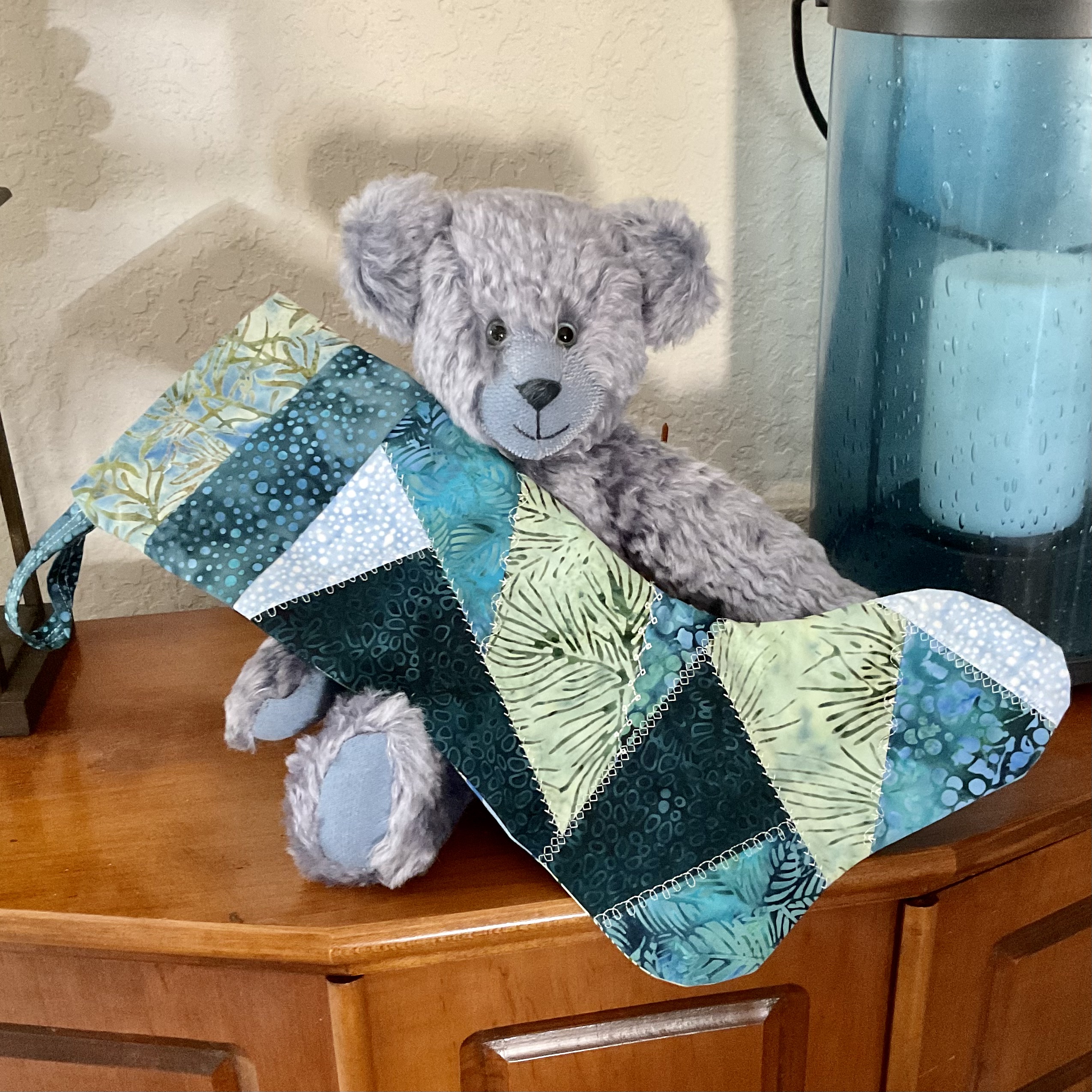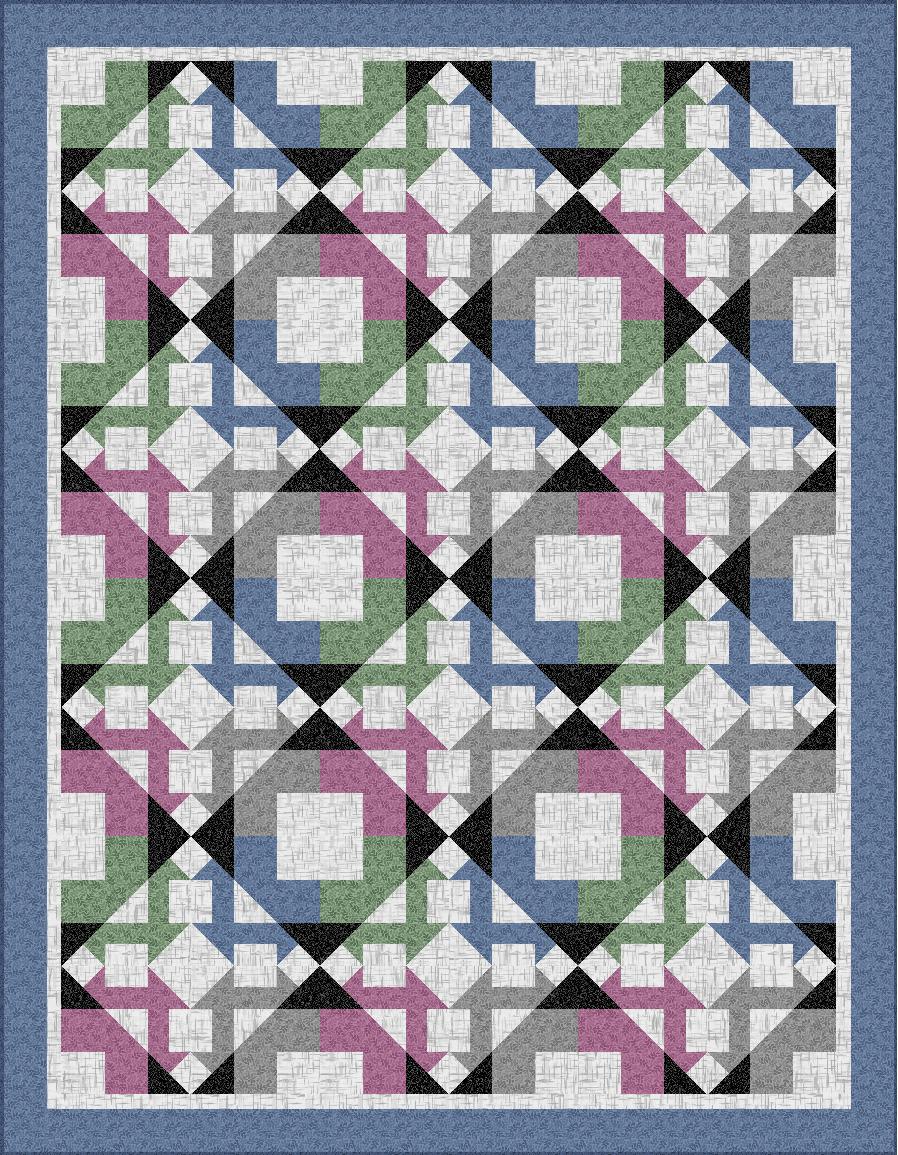
This month’s challenge is called Creative Christmas Stockings and the Island Batik Ambassadors will all be making stockings and can choose whatever fabric they like from Island Batik. Maybe some will do unusual piecing or appliqué; maybe some will make stockings in unusual shapes or small gift bags. I can’t wait to see what the other Ambassadors are going to come up with this month. At the bottom of this blog, I have links to the other designer’s blogs so you can see what they made.

I wanted to make a crazy quilt stocking with a blue wintery theme. I chose the Mountain Gems line by Kathy Engle as my main fabric. Just look at this gorgeous collection of batik fabrics. The Mountain Gems collection may be found at your local quilt shop that carries Island Batik, such as Fabric Smart in St. Petersburg FL. You may find them online at www.fabric-smart.com or call them at 727-914-8850.


I chose to make a crazy quilt stocking using the Crazier 8 templates from Creative Grids and the Studio Stocking Die set from Accuquilt. Crazy quilting is where the shapes are cut at odd angles and then sewn together. Decorative stitches are then sewn over the seam lines, so they show, on the good side of the fabric. Blue Bear and Beauregard Bear are thrilled with their new stocking.


The Crazier Eight templates were used to make crazy quilt blocks and the Accuquilt Studio cutter and die set were used to cut out the stocking shapes. The Studio dies look different from the Accuquilt GO! dies in that they are made of wood with steel blades and foam surrounding the steel blades. They are used in the Studio cutter, which is a more industrial and manual cutter that can cut up to 12 layers of fabric at a time. This is great for quilt shops or designers that need to cut a lot of fabric. If you would like to see a video of how I cut out shapes with an Accuquilt cutter, there is a video on my You Tube channel-Blue Bear Quilts. Here is the link to the You Tube video: https://youtu.be/3-hp6QzFkOo. In this video, I am using an electric GO! Big Cutter, as opposed to the Studio Cutter I used to make this stocking which is manual, but the concept is the same.

The great thing about the Crazier 8 template set is that you can cut out the shapes you need for an 8″ block from 10″ squares and you can buy the Mountain Gems fabric in 10″ squares. The squares need to be cut in half diagonally as you can see in the next photo.

In the next photo, you can see how shapes A, B and C are cut out from one half of the fabric, with the Creative Grids Crazier 8 templates, and shapes D and E are cut out from the other half. This makes it easy to cut multiple layers of fabric at a time. The templates also cut off the dog ears which make lining up the pieces easy to sew and no trimming when done. A rotating mat is helpful when cutting out these shapes.


The photo above shows a Crazier 8 block sewn together. You sew shapes A, B and C together first and then sew shapes D and E together. Finally, you sew the two halves together. Next I sewed three blocks together to create a blocky stocking shape.

Then I applied byAnnies.com Fusible Stabilizer to the back, which was used to stabilze the decorative stitching that I would be putting on the front of the fabric. I had to make one of these for the front of the stocking and one for the back. The decorative stitching had already been done in this photo. And the next photo shows a close up of the decorative stitching I did using my Janome 6600.


Now that the crazy stitching is all done, it’s time to cut out the stocking shapes. I have my two crazy patchwork pieces, one is a mirror image of the other, and two pieces for a fabric lining. I lay them over the stocking die and crank them through the machine and perfect stocking shapes are cut out.

One needed to be laid on the die right side up and the other wrong side up. The same thing would be true for the lining fabric, but its is not as crucial with batik fabric as both sides look good.

I also made a pieced cuff for the stocking by sewing strips on both sides of another piece of fabric and then cutting out the cuff with the other Accuquilt die that is part of the set.

Unfortunately I forgot to take photos of sewing the stocking together. You start by sewing the interior curve of both the outside pieces, and the lining, from the top of the cuff down to the top of the curve. You then sew the top of the exterior pieces to one side of the cuff and the top of the lining pieces to the other side of the cuff. Next, you flip them right sides together and pin all the way around and leave a small opening. You sew 1/4″ all the way around, except for the opening. Finally you turn everything right side out, stitch the opening closed, and then stuff the lining into the stocking.
I hope you have enjoying reading how I created this Christmas Stocking. Stay tuned for next month when I reveal a lone star quilt.
The supplies I used to make this project were provided by:
Island Batik Mountain Gems fabric.
Aurifil 50 wt cotton thread
Schmetz 70/10 quilting needle
byAnnie fusible stabilizer



If you are on TikTok, be sure to follow me there for more quilting antics. (Look for Blue Bear Quilts)
Blue Bear and Beauregard Bear hope you like their stocking. Please let them know how much you love them by writing to them in the comments!
The other amazing Island Batik Ambassadors are also posting their November Challenge stockings. Check out their projects by clicking on the links next to their names to be directed to their blog posts.
Gail Renna, Quilt Haven Threads
Michelle Roberts, Creative Blonde Gifts
Sandra Starley, Textile Time Travels
Jennifer Thomas, Curlicue Creations
Brenda Alburl, Songbird Designs
Jennifer Fulton, Inquiring Quilter
Lisa Pickering, Lisa’s Quilting Passion
Suzy Webster, Websterquilt
Denise Looney, For the Love of Geese
Gail Sheppard, Quilting Gail
Preeti Harris, Sew Preeti Quilts
Connie Kauffman, Kauffman Designs
Megan Best, Bestquilter
Maryellen McAuliffe, Mary Mack Made Mine
Elizabeth DeCroos, Epida Studio
Jane Hauprich, Stitch by Stitch Custom Quilting
Emily Leachman, The Darling Dogwood
Andi Stanfield, True Blue Quilts
Leah Malasky, Quilted Delights
Claudia Porter, Create with Claudia
Mania Hatziioannidi, Mania for Quilts
Reed Johnson, Blue Bear Quilts
Pamela Boatright, Pamela Quilts
Anorina Morris, Samelia’s Mum
Brianna Roberts, Sew Cute and Quirky
Make sure to follow Island Batik on social media. Be sure to check out the Island Batik Blog.
#islandbatikambassador #islandbatik #iloveislandbatik #byannie #aurifil #aurifilthread #schmetzneedles #Janome #creativegrids #Accuquilt #Bluebearquilts























































